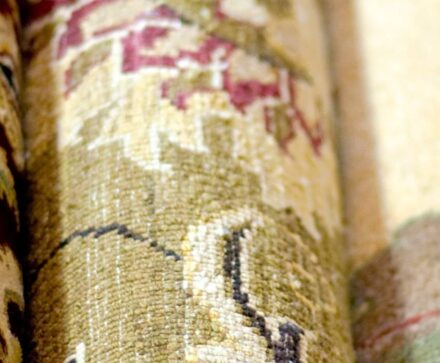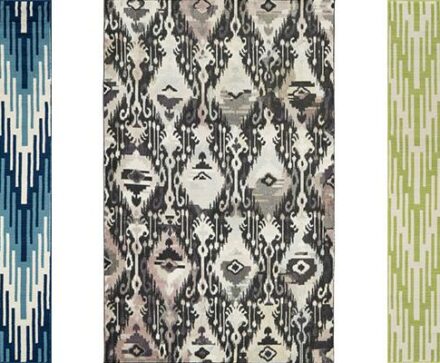Cleaning Oriental Rugs After a Home Flood
Sometimes floods or sewer backups are unavoidable and homeowners deal with damage to precious Oriental rugs. Sam Presnell, owner of The Rug Gallery, talks about how to properly store for a rug and how to care for it if it undergoes water damage. Listen or read more to find out about Oriental rugs and floods.
John Maher: Welcome to The Rug Gallery with Sam Presnell. The Rug Gallery is an Oriental rug company and carpet store in Cincinnati, Ohio. I’m John Maher, and I’m here with the owner of the Rug Gallery, Sam Presnell. Hi, Sam.
Sam Presnell: Hi, John.
John: Sam, today we’re talking about Oriental rugs and floods. Flooding is an issue, maybe you have broken pipes in your house or ice dams, if you’re where I am, in the northeast, and in the winter time, or maybe just natural flooding with the rising waters and things like that. What can happen to a rug when it gets wet?
Sam: That’s a very common problem we all have anywhere you live, but we see a lot of that here in Cincinnati and that’s one of the issues we deal with on a frequent basis. The big thing is, if you leave a rug wet enough, long enough, depending on what the rug’s made out of, and it usually will have some color bleed. Sometimes you have mildew and funguses, that can also happen as well. You get black spots, white spots, you see color run. Those are the more common things.
Where to Store a Rug to Avoid Water Damage
John: If I know that an area of my house might typically flood, maybe my basement and I know I have a rug down there, what should I do?
Sam: Exactly. Do not put it on the ground or the floor of the basement. I always tell everybody when they say they’re going to store their rug and they don’t know what to do with it and the kids don’t want, I said, “I don’t mind you storing it, but at the same time don’t put on the floor because if it’s going to get wet or moisture, that’s where it’s going to happen at. If you could put some bricks up or blocks up and put some planks or whatever on top of there and set the rug on that, that’d be great.”
It’s hard to say when it’s a real serious flood that that’s going to help, but at least you can get it off the floor by six inches or a foot — that’d be very helpful, just in case accidents do happen or backups happen.
John: Do you recommend storing a rug in an attic if that’s an option for you in your home?
Sam: The attics also present certain problems with bugs and pests [and] moisture as well. There really is no ideal situation there because you don’t usually go up there enough. I’m not a big fan of attics because a lot of people just don’t visit them. There can be drips or drops that can happen and roof leaking. You have a lot of moisture if you live in very humid areas that change, get a lot of moisture inside if you wrap it in plastic, you’ll see a sweating, which we would call mold, mildew.
I’m not a big fan of attics over basements or anything like that. The big thing is, I would prefer a basement over an attic. Basically, the best thing is to check on [it] every now and then to make sure that it is doing okay and aging well.
John: Just get it up off the floor if you do put it in the basement, like you said.
Sam: Definitely.
Caring for a Rug After a Flood
John: If my rug does get wet due to flooding what should I do?
Sam: Get it dry as you can, as fast as you can. That’s the key. If you have a Shop-Vac, Shop-Vac the heck out until you can’t get any moisture out of it anymore. Put fans on it. Try to put stuff underneath the rug so that it’s off the floor so you’re getting air underneath it as well as on top of it and get it dry as fast as you can. Because that’s where the molds, the mildews creep up very quickly if you’re not careful. If it’s humid enough they tend to grow on their own almost.
John: Is there anything that can be done with a rug once some mold or mildew grows on it?
Sam: It depends. I would say 90% of the time, no. It can usually ruin a rug and it can basically weaken the rug as well, which means that the protein in the rug starts breaking down and it becomes very fragile. I would have to say, when you get to that point, most of the time it’s not a good situation. You have to usually dispose of it. Sometimes, I have seen, we’ve treated it different ways with different chemicals and different stuff that you can use in mold and mildew extractions that has worked, but it also depends on how quickly you get to it.
John: That’s really great information, Sam. Thanks again for speaking with me today.
Sam: My pleasure. Thank you.
John: For more information about Sam, The Rug Gallery, and Oriental rugs and carpets, visit ruggallerycincy.com. That’s Rug Gallery C-I-N-C-Y.com or call 513-793-9505. Make sure you catch the latest episodes by subscribing to this podcast on iTunes and if you could take the time to give us a review, as well, we would appreciate that. I’m John Maher. See you next time on The Rug Gallery.




